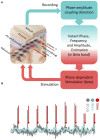Perspective: Phase Amplitude Coupling-Based Phase-Dependent Neuromodulation in Parkinson's Disease
- PMID: 33132822
- PMCID: PMC7550534
- DOI: 10.3389/fnins.2020.558967
Perspective: Phase Amplitude Coupling-Based Phase-Dependent Neuromodulation in Parkinson's Disease
Abstract
Deep brain stimulation (DBS) is an effective surgical therapy for Parkinson's disease (PD). However, limitations of the DBS systems have led to great interest in adaptive neuromodulation systems that can dynamically adjust stimulation parameters to meet concurrent therapeutic demand. Constant high-frequency motor cortex stimulation has not been remarkably efficacious, which has led to greater focus on modulation of subcortical targets. Understanding of the importance of timing in both cortical and subcortical stimulation has generated an interest in developing more refined, parsimonious stimulation techniques based on critical oscillatory activities of the brain. Concurrently, much effort has been put into identifying biomarkers of both parkinsonian and physiological patterns of neuronal activities to drive next generation of adaptive brain stimulation systems. One such biomarker is beta-gamma phase amplitude coupling (PAC) that is detected in the motor cortex. PAC is strongly correlated with parkinsonian specific motor signs and symptoms and respond to therapies in a dose-dependent manner. PAC may represent the overall state of the parkinsonian motor network and have less instantaneously dynamic fluctuation during movement. These findings raise the possibility of novel neuromodulation paradigms that are potentially less invasiveness than DBS. Successful application of PAC in neuromodulation may necessitate phase-dependent stimulation technique, which aims to deliver precisely timed stimulation pulses to a specific phase to predictably modulate to selectively modulate pathological network activities and behavior in real time. Overcoming current technical challenges can lead to deeper understanding of the parkinsonian pathophysiology and development of novel neuromodulatory therapies with potentially less side-effects and higher therapeutic efficacy.
Keywords: Parkinson’s disease; cortical stimulation; motor cortex; neuromodulation; phase-amplitude coupling; phase-dependent stimulation.
Copyright © 2020 Hwang, Salimpour, Tsehay, Anderson and Mills.
Figures


Similar articles
-
Phase- targeted stimulation modulates phase-amplitude coupling in the motor cortex of the human brain.Brain Stimul. 2022 Jan-Feb;15(1):152-163. doi: 10.1016/j.brs.2021.11.019. Epub 2021 Nov 30. Brain Stimul. 2022. PMID: 34856396
-
Pallidal deep brain stimulation modulates excessive cortical high β phase amplitude coupling in Parkinson disease.Brain Stimul. 2018 May-Jun;11(3):607-617. doi: 10.1016/j.brs.2018.01.028. Epub 2018 Jan 31. Brain Stimul. 2018. PMID: 29422442 Free PMC article. Clinical Trial.
-
Phase-dependent Stimulation for Modulating Phase-amplitude Coupling: A Computational Modeling Approach.Annu Int Conf IEEE Eng Med Biol Soc. 2020 Jul;2020:3590-3593. doi: 10.1109/EMBC44109.2020.9175966. Annu Int Conf IEEE Eng Med Biol Soc. 2020. PMID: 33018779
-
Beta-Gamma Phase-Amplitude Coupling as a Non-Invasive Biomarker for Parkinson's Disease: Insights from Electroencephalography Studies.Life (Basel). 2024 Mar 15;14(3):391. doi: 10.3390/life14030391. Life (Basel). 2024. PMID: 38541715 Free PMC article. Review.
-
Earlier Intervention with Deep Brain Stimulation for Parkinson's Disease.Parkinsons Dis. 2017;2017:9358153. doi: 10.1155/2017/9358153. Epub 2017 Aug 16. Parkinsons Dis. 2017. PMID: 28951797 Free PMC article. Review.
Cited by
-
Open Hardware Implementation of Real-Time Phase and Amplitude Estimation for Neurophysiologic Signals.Bioengineering (Basel). 2023 Nov 23;10(12):1350. doi: 10.3390/bioengineering10121350. Bioengineering (Basel). 2023. PMID: 38135941 Free PMC article.
-
The Supplementary Motor Complex in Parkinson's Disease.J Mov Disord. 2022 Jan;15(1):21-32. doi: 10.14802/jmd.21075. Epub 2021 Nov 25. J Mov Disord. 2022. PMID: 34814237 Free PMC article.
-
γ neuromodulations: unraveling biomarkers for neurological and psychiatric disorders.Mil Med Res. 2025 Jun 27;12(1):32. doi: 10.1186/s40779-025-00619-x. Mil Med Res. 2025. PMID: 40571935 Free PMC article. Review.
-
Novel approaches for quantifying beta synchrony in Parkinson's disease.Exp Brain Res. 2022 Apr;240(4):991-1004. doi: 10.1007/s00221-022-06308-8. Epub 2022 Jan 31. Exp Brain Res. 2022. PMID: 35099592 Review.
-
Cortical phase-amplitude coupling is key to the occurrence and treatment of freezing of gait.Brain. 2022 Jul 29;145(7):2407-2421. doi: 10.1093/brain/awac121. Brain. 2022. PMID: 35441231 Free PMC article.
References
LinkOut - more resources
Full Text Sources

